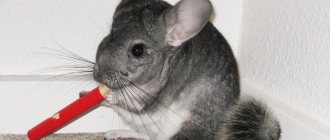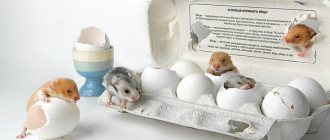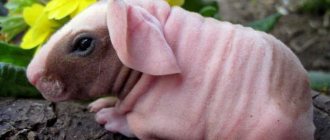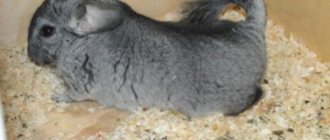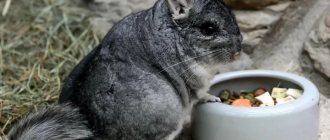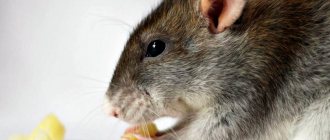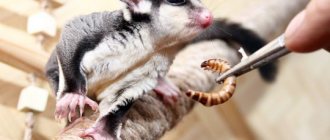Chinchillas A chinchilla is a rodent from the chinchilla family, externally similar to something in between... known both as pets and as fur-bearing animals. Funny appearanceA species is an evolutionarily developed set of individuals, characterized by a single... and cheerful disposition make these animals real pets. But since the chinchilla is a rodent from the chinchilla family, which looks like something in between... and comes from the distant South American Andes, not everyone knows what conditions need to be created for keeping these animals at home.
Chinchilla and its maintenance at home: let's start with studying the appearance
Interesting: At the beginning of the 20th century, the wild rodent was practically destroyed because of its valuable fur and was listed in the Red Book. When the threat of extermination arose, many tried to save the animal, but all attempts to keep the chinchilla at home ended in its death! For the first time, M. Chapman managed to transport a rodent from the mountains in 1973, who began breeding them on a farm with 3 females and 8 males!
In nature, there are generally only two varieties of this rodent - the small long-tailed chinchilla and the large short-tailed chinchilla, the content of which is no different. They all have a natural gray color called agouti - darker on the back, lighter on the belly and paws. But in captivity, breeders have bred more than 40 different breeds of chinchillas, distinguished by a variety of colors. Now you can buy a chinchilla not just white, but velvety white. But that's not all - there are animals of beige with a pink tint, sapphire or purple color.
Species and habitat
- Chinchillas are cute, charming animals that are easily tamed, tolerate captivity well and have a lifespan of 12-15, and sometimes up to 20 years. Their weight is 500-800 g, while females are always larger than boys
- Body length - 25-38 cm
- Tail length – 8-17 cm; The short-tailed species has very massive hind legs and neck
Important: But do not forget that basic animal hygiene items such as sand or litter do not have such hypoallergenic properties. Therefore, if you have a predisposition to allergies or asthma attacks, then it is worth considering this aspect. Although, if you think like this, then any animal may be prohibited for you, since in any case there will be risks!
Review
Rules for caring for light fur
The main reasons why fur turns yellow:
- High humidity.
- Dust.
- Natural human secretions: sweat and sebum.
To prevent trouble, follow these rules:
- Do not wear a fur coat in snow or rainy weather. Do not store it in areas with high humidity.
- If your fur coat gets wet, dry it thoroughly, but not near heating appliances, but using a fan or hairdryer with cold air.
- It is advisable to store a fur product in a dry, dark place, in a plastic or fabric cover.
- Take off your fur coat in warm rooms, avoid excessive sweating.
- Regularly clean the fur from dust and comb it using a special brush.
A fur coat must be protected from moths. To do this, place orange peels, tobacco or geranium leaves in fabric bags and place them in the closet.
| Over time, all natural fur tends to change color. When exposed to bright light, the pigment contained in the hairs burns out. This is especially noticeable on products with white fur. The yellowness that appears takes away the charm of white fur products and makes you think about ways to return the whiteness of your favorite item. |
Completely getting rid of yellowness is a difficult task and not always feasible, but there are folk methods with which you can significantly correct the color. There are also specialized dry cleaners that undertake this type of work, but they are rare and require a lot of money for this service. At the same time, we must remember that dry cleaning wears out the fur a lot, and the product itself can “shrink.”
Keeping chinchillas: learning signal sounds
A chinchilla, which can be kept at home or in the wild, always makes sounds that are very diverse in volume and tonality, which always mean something:
- cooing sound - satisfaction;
- a sound similar to a duck quack - pleasure from food while eating;
- tweeting and quacking - dissatisfaction;
- blowing your nose and growling (sometimes accompanied by clicking your teeth) – indignation;
- a frequently repeated squeak – the cub is calling its mother;
- a sound similar to crying - a stressful state;
- a sharp piercing squeak - fear and pain;
- a sound similar to the intermittent barking of a dog - a warning of danger;
- a menacing, abrupt sound similar to a growl - a war cry.
Important: But chinchillas are very afraid of sharp and loud sounds, especially screaming and music, as well as bright light! A strong and sharp bang, for example, can even lead to death. It is especially important to maintain silence during the adaptation period!
For this reason, it is dangerous to have a chinchilla in families with small children. Also, due to the fact that the animal is considered exotic, anyone under 12 years old should refrain from purchasing it!
They are very friendly and smart
Selection of combs
When choosing a comb for a chinchilla, it is important to remember that an ordinary comb used by people for daily toileting, as well as brushes for dog hair, will not suit the animal.
Experts confirm that some models of combs for cats can be useful for combing, however, the most successful option for solving the problem would be to purchase a special device for rodents.
Chinchillas have soft and very thick fur, since one hair follicle can produce about 80 hairs. That is why the main signs that you need to pay attention to when choosing a comb for a rodent are:
- the ability to freely penetrate the animal’s “hair”;
- long and thin teeth;
- lack of qualities of a “slicker”, which causes unpleasant sensations to the rodent due to the removal of not only fallen hairs, but also rooted hairs;
- blunt teeth that do not harm the skin.
Keeping chinchillas: behavioral characteristics, character
The main characteristics of their behavior:
- Chinchillas are characterized by a twilight and nocturnal lifestyle. They sleep most of the day, and the evening is when their activity peaks. Therefore, when purchasing a chinchilla, be prepared for night sounds, running around and rattling bowls. Ideally, it is better to keep a chinchilla in a separate room.
- Chinchillas, especially young and unsocialized ones, are very timid and susceptible to stress; they have difficulty withstanding a change of environment and traveling in public transport, and may be frightened by unfamiliar objects. Let us repeat that in case of severe fright they may even die from a broken heart. Therefore, from the moment the animal appears in the house, it needs to be socialized, gradually accustomed to handling and communicating with people. And remember - you should pick up a chinchilla slowly, without pressure.
- Each animal has an individual character, but also great curiosity - this is their common feature. They are attentive to everything that happens in the house, learn everything new with interest and watch people.
- And of course, such a fluffy and cute rodent loves to “scratch” its teeth on wires, flowers or pieces of furniture. For this reason, you should not let him roam freely around the apartment.
- But you can safely leave the rodent at home while you are at work. This is a big plus for busy people - a chinchilla does not need constant care and affection, like a cat, or a daily walk, like a dog. In this case, you can even leave your pet for 1.5-2 days during the trip. Of course, it’s better to leave them completely unattended!
- She doesn't bite, doesn't scratch, and is generally a very friendly, non-aggressive animal!
- It is also worth noting that the chinchilla does not need a mate; it is perfectly fine alone. Compared to hamsters, one of them can become very bored and even die. Keeping furry rodents in pairs creates more trouble - they make a lot of noise, and sometimes even compete. Moreover, this applies to both same-sex and opposite-sex animals.
- If you want to have a couple, then they need to be properly made friends and placed next to each other. Therefore, ideally choose rodents you already know. Breeding a chinchilla if it is kept in a private home is not easy, but it is still possible. True, there are many limitations. For example, cohabitation is prohibited for six months after childbirth. In an apartment or small area this is almost impossible. You can read more information in our article “How to breed and mate chinchillas: tips for pregnancy and childbirth”
Important: It has been noted that chinchillas that are in pairs are less tame!
Key facts
Farm organization
Premises requirements
- Space. To keep 50 females, you can set aside a room in a residential building or make a small aisle. For a larger population, it is necessary to build a separate brick or wooden building.
- Daylight. It is necessary to have daylighting, which has a beneficial effect on the animals’ metabolism and fertility. In order for all cages to be equally illuminated, they must be installed along the windows; direct rays of the sun should not fall on the animals. Windows should be covered with mosquito nets.
- Artificial lighting. Nocturnal animals will need an additional light source. To do this, you need to use lamps of 5 W/sq.m.
- Temperature. The indicator should be constant and vary from 18 to 20 ⁰С. In winter, heaters will be needed to maintain warmth. For control, mercury and electric thermometers are used.
- Humidity. The optimal humidity level for chinchillas is 55-65%.
- Ventilation. The supply of fresh air and the removal of excess moisture, gases, dust and bacteria is an important point when keeping animals with weak immunity.
- Soundproofing. If the room is located in close proximity to a residential area, then at night rodents will disturb the sleep of all household members. The chinchillas themselves should also be protected from loud, sharp sounds.
Keeping chinchillas: choosing a cage, a display case for a house, apartment, how to arrange it - rules
In order for your animal to be healthy, happy and make you happy with its existence, it is necessary to provide it with normal living conditions. But it cannot be said that chinchilla has very limited content. They are relatively unpretentious, just quite impressionable.
Take care of the house where your pet will live
- It should be a spacious cage, at least 70 cm high and 50 cm wide, allowing him to run and jump freely. Please note that the distance between the rods should be no more than 2 cm. And it’s even better if you provide your pet with a so-called showcase - a taller and more spacious structure made of natural materials - wood, chipboard or fiberboard with three blank walls and an open front fine mesh side. The display case has a number of advantages over the cage - garbage does not spill out of it, it is easier to clean and the animal feels more comfortable in it.
Cage, display case and bath tray
- Approximate plan for placing objects: The cage or display case should have shelves on which the chinchilla will happily run. In general, the animal prefers heights. And also, if space allows, it is advisable to install a running wheel and a hammock for entertainment;
- house should be built in a separate corner in which the animal will rest. Ideally, make it from wood, but a plastic analogue will also work. The main thing is that there is a roof and a minimum of holes. The chinchilla will use it to hide from prying eyes. It should be cleaned once every 5-7 days;
- should be hung nearby . They should never be placed on the floor because they may be overturned during play. In this matter, regular rodent devices will do. They should be placed approximately 5-10 cm from the base;
- The tray with the filler should be located on the opposite side of the cage;
- The floors should be covered with carpet or sawdust. It is very good to use pine litter for the tray, as it also disinfects the animal’s paws well;
- Be sure to buy a tray for bathing in the sand. Yes, not just, but zeolite! Zeolite is of volcanic origin and is suitable for bathing furry rodents. It needs to be cleaned approximately once every 2 weeks. The tray dimensions are approximately 20 by 30 cm. By the way, you can make it yourself from a plastic flask or canister. Above in the photo we showed an example;
- It also wouldn’t hurt to put stones for sharpening teeth or chalk stone, tree branches;
- Don't forget about toys. As a piece of advice, she will much more appreciate just the same branch, a wooden construction set, cubes or walnut shells. You can build a tunnel from pipes;
- Buy a hay box - although the chinchilla is clean, it is more convenient to take the hay from a special container. By the way, if grass falls on the floor, be sure to pick it up. This way you will prolong the cleanliness in the cage!
Important: General cleaning of the house should be done once a month. Do not use disinfectants for the toilet under any circumstances - they are extremely dangerous for the animal’s respiratory system. Treat with soda, or soda ash - it disinfects perfectly, has no odor, is harmless and costs a penny. We wash all items, pour boiling water over them and rinse with cold water, and finally wipe everything well!
You will also find useful information on how to train an animal to use its own toilet.
How to train to the tray
Choosing pet food
When kept at home, the rodent's diet should be balanced. The basis is granulated and grain mixtures. They contain seeds, grains and dried fruits that are suitable for the chinchilla's digestive system. Premium food is rich in vitamins and microelements. Hay must be present on the animal’s menu; it improves the functioning of the digestive tract. As additional complementary foods, you can give dandelion, clover or spinach leaves. A piece of carrot, apple or nuts is considered a tasty treat. Sunflower seeds and nuts should be raw so as not to burden your pet’s stomach. Do not feed rodents flour products and leaves of indoor plants.
Keeping chinchillas: how to make friends with the animal?
- Don't force your friendship! Keeping chinchillas is only voluntary - give the animal time to adapt to the new house. It is possible that his appetite will even temporarily disappear or worsen. But this is only for a few days. Continue to change food on time and wash bowls.
- And when the rodent has settled into its new home, which takes approximately 2-5 days, you can move on to the acquaintance stage. But don't grab him right away! For this reason, it will be extremely difficult for families with children to adapt a chinchilla, because it will simply be even more frightened by the sudden pressure and move away even more. In addition, as we have already said, her heart can stop from fear.
- All these days we walk and pay attention, but we don’t sit for hours near the cage, knocking on the house - when the rodent gets out and runs around on a wheel. Leave her alone, but every time you pass by, turn to her and talk. At this stage you can give her a nickname.
- It is recommended, but not all family members should do this and not every hour, to give her a treat. In general, we lure them through food. Ideally, give it by hand, but at first just put the food in the cage so that the rodent can see it while talking to it. They love raisins very much, but they can eat no more than 1 piece per day. And you should give it in half or a quarter, because it weakens greatly! We use this method only at the acquaintance stage or in extreme cases.
- Then we move on to the next stage - we open the door and try to feed him by hand. Over time, the animal will gain courage and take its first steps towards you. Sometimes they can express the joy of waiting for a tasty treat with sound - this is also a good sign.
- Then try scratching the rodent behind the ear or under the chin. Over time, the pet will take this step - this is already the stage of rapprochement. And after that you can try to pick him up.
- Also, if a chinchilla doesn’t want to go out for a walk, then he doesn’t force it, but usually the question is framed differently - she doesn’t want to go in. To do this, we lure them with raisins or a bathing tray. If this number does not work, then carefully take it at the base of the tail, and hold it from below with your other hand.
- And one more word - the chinchilla is restless, so don’t expect it to sit in your arms to be petted.
We lure you with treats
Combing rules
You can learn how to comb your furry pet yourself by following simple recommendations from experts. Remember the basic tips and sequence of actions:
- Place the rodent on a flat surface, securing it at the base of the tail.
- If your pet is nervous and aggressive, position him so that his back paws are not in contact with the surface.
- Start combing the animal from the back with even, short movements.
- Finish combing the belly fur.
- Additionally, comb the fur around the anus.
During the combing process, fallen hairs often stick to the rodent's fur. Gently remove them with a cleaning roller, without causing pain to your pet by applying excessive pressure.
Keeping a chinchilla at home: reviews from owners
A chinchilla is just a fluffy ball of incredibly soft fur. And one cannot call them too picky in matters of maintenance, but chinchillas, like all rodents, require certain conditions. Let's look at real reviews from owners who got this pet.
Veronica, 28 years old
I really wanted a chinchilla after I held it in my hands at the tactile zoo. She, of course, immediately cost more than a regular hamster, but desire took over. I'll start with something pleasant. Very beautiful, soft and interesting. You can really watch her for hours. Regarding nutrition - like an ordinary rodent, it eats corn, peas and other grains, hay. You can buy it at any pet store without any problems. She doesn't smell at all! This is a big plus! You don't need to bathe her, but I'll talk about sand later. As advice from me, you need to take a solid wheel. Otherwise, the chinchilla's paw may become sharp between the bars, and it may break! And all because the chinchilla runs by jumping.
This is my beautyAnd now I’m telling you about my mistakes! First, I took a small cage. Good thing, at a friend’s dacha I found a wooden shelving unit with a mesh door attached to it. She needs a lot of space to play, so even standard cages for chinchillas are best taken to the maximum size, with at least two floors. My second disappointment is that she doesn’t just walk in the evening, but late in the evening, after 10 and until the morning. In general, in my one-room apartment this noise was simply incredibly tiring. Another mistake I made was letting him go for a walk without a ball! I chewed through the internet cable. It’s good that the animal was not hurt, but the Internet was lost. There are still more disadvantages than advantages - she litters like an ordinary hamster. I thought it was a very smart and clean animal. Perhaps it’s not the chinchilla that’s the issue here, it’s just that, like any rodent, it goes to the toilet with peas and eats hay and grain! And you need to monitor the cage, if not every day, then definitely every 2 days. I vacuumed my apartment twice a day and it was still always dirty. I am mostly at work, so for me such cleaning before going out and upon arriving home took a lot of time.
As a result, after 4 months of torment we had to say goodbye - the owner was found quickly. In general, my verdict is this: a very beautiful and interesting animal. But this is a nocturnal rodent, albeit a furry one! Therefore, he needs a noise-isolated room so that he does not disturb his sleep during the day, and he does not disturb people at night.
Elizaveta, 32 years old
I'm very happy with the purchase - our whole family is crazy about it. It's been exactly a year since we got a new family member. I won’t tell you how cute and beautiful they are - you can already see from the photo. I will dispel the main myths and tell you what it is like to become the owner of a chinchilla. She is not picky, but needs special care. And the first thing is a lot of space. We have a private house, two floors. Therefore, her noise at night does not bother us, and she sleeps most of the day. She needs a big house and a lot of toys in it. We bought this display case for 5 thousand rubles. By the way, the purchase itself for the first time cost more than 13 thousand!
This is our house and foodAs you can see, we have a lot of food supplies - and that's not all! The chinchilla does not eat much, but requires a variety of food. If she is tired of food, she will throw it out through the cage and refuse it completely. But this is not the worst thing - monotony in food can also cause digestive problems. Their stomach is very receptive and they should be given absolutely clean things - I prepare many of them myself when I come to my parents in the village. The second point that chinchilla owners are often not ready for is cleaning. What do you expect when you buy a rodent? She is relatively very clean and does not smell like hamsters, for example. But you need to clean it at least 2-3 times a week or when it gets dirty. If you have a cage, place a tray underneath - this will significantly reduce the time. With a showcase, everything is much simpler. But I do every day:
- I give you something to drink and eat, it’s always fresh, even if there’s some left over
- I monitor the temperature and humidity
- I'm removing boluses. Speaking of them, on a chinchilla they should not smear; after a short period of time they become hard.
And I do this about 3 times a week:
- my feeder and water bowl
- I wipe the cage itself and all the toys and shelves
- I'm doing disinfection
- I put the bathing suit on
loves to sit in her arms
. She is very friendly, she makes contact quickly, but she is afraid of some guests, especially small children. She's scared of the noise! Our daughter is already an adult, so there were no problems with this. But if you have children who are under 10 or at least 8 years old, then do not torture the animal! She bathes in a very interesting way - this action still delights us all. Chinchillas can rearrange objects themselves - be prepared for this. They are very fast, smart and cunning, especially if they want to get out of the cage. You definitely can’t walk them on a leash; even around the house you only need to walk in a ball or under supervision! They have soft claws so they don't scratch or bite. For me, this is an ideal pet, which, like any type of animal, requires a little attention and care!
Keeping chinchillas is not particularly difficult, but relatively expensive. Although just such a pet will be an indicator of your high position, because not everyone can afford a chinchilla. And it’s not even a matter of finances, she’s a little demanding about the proper space for games. In addition, you should have your pet’s own room - after all, this is a nocturnal rodent that loves to make noise at night.
How to make a rack and ladder
For the rack, pieces of plywood are suitable, which can be attached to the walls of the home using wire or a self-tapping screw. The higher the cage, the more shelving.
The ladder serves as both an element of the game and a delicacy. It is made from branches of different thicknesses, mainly using willow, birch, poplar or rowan. It is more convenient to work with dry twigs. The raw material can be easily dried in the oven, on the stove or by the fireplace.
The branches need to be divided: short ones - into crossbars, long ones - into shelves. In the center of the crossbar, drill a hole of 2-3 mm, as in the shelves, stepping back from the edges of the last 2 cm. Wire will help to fasten the chains of the ladder. The racks are fastened as follows: the end of the wire is pulled through the first shelf, a crossbar is put on it, and fixed on the other shelf with a loop.
